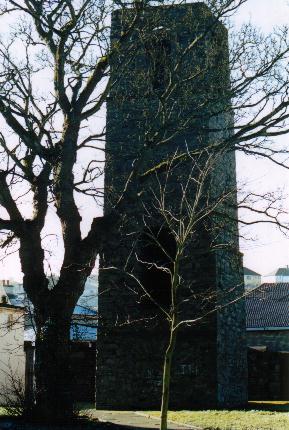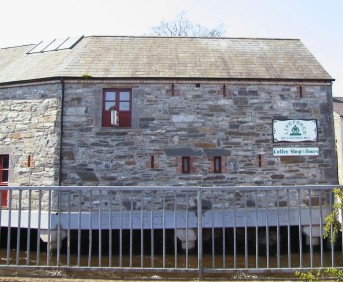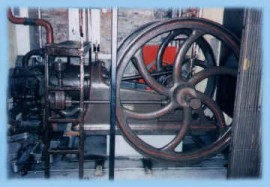Click on the frog to return to the top of
the page.
[The Franciscan Abbey ] [The Lifeforce Mill ]
As the town was burned several
times, (for the last time in 1690), there are no buildings that
can be dated back to the seventeenth century and very few to the
18th century. The tower attached to the Franciscan Friary is
possibly the oldest building remaining. It dated from the middle
of the 18th century.The Maxwell family of Farnham who owned most of the town were responsible
for the laying out of Farnham Street and were responsible for the
erection of the Courthouse and the Church of Ireland Church. The
majority of buildings in the town are built of sandstone taken
from the local Latt quarry, just outside the town.Cavan No.1 is
situated at the junction of Abbey Street and Farnham Street in
Cavan Town.
The Franciscan Abbey:
 |
The Franciscan Friary in
Cavan, better known locally as St. Mary's Abbey, was
founded by in 1300's by Giolla Iosa Rua O'Reilly, the
king of Breifne. The Franciscans tended to settle in or
near towns and cities. Their task was to carry religion
into the marketplace. The Cavan friary was close to Cavan
Town. 
The 1593 Map of Cavan shows
the Franciscan Friary church and the bell tower.It showed
the church with an east west orientation and with an
external tower. The tower is approximately forty feet
high . It is open, has rounded arches in east and west
walls, one large window facing east on the first floor
and windows with rounded tops on the top storey.
|
The friary and
lands attached to it remained in the possession of the
Franciscans for nearly three hundred years. The friary
was burned on many occasions. In 1429 it was burned by
the English, in 1452 by a monk using a candle, in 1468 by
the English and in 1575 by one of the O'Reillys.
It is believed that Owen Roe O'Neill, who died at Lough
Oughter Castle on 6th November 1649 was buried in the
Franciscan Friary, but his grave was not marked.The
church passed out of the ownership of the Franciscans in
the early 1590's and was used as a court. It was later
rebuilt by the Church of Ireland and used as a parish
church until the present church was built in 1815. The
last service was held on Christmas Day1815. It became a
ruin in the early 1820's and the stones were taken away
and used to build houses on Main Street. All that remains
today is the tower that is around 40 feet high.  The Lifeforce Mill:
|

|
The Lifeforce Mill is
situated along the Kinnypottle River. Milling on this
site can be traced back to the 14th century, when the
mill was part of the Franciscan Friary.The current mill
formerly known as Greene's Mill was built in 1846 and
closed its doors in the 1950's. The mill was fully
restored in the 1990's All the original machinery,
including what is believed to be the only McAdam Water
Turbine has been restored and returned to use.The flow of
the Kinnypottle is harnessed to drive the enormous stone
wheels which grind the wheat into flour.  |

|
The McAdam
Water Turbine |
| The mill produces
Lifeforce Stoneground Flour, which is then used to make
brown bread. 
|

|
[An Introduction to Cavan Town ] [ Buildings on Farnham Street] [Schools in Cavan] [Famous people associated with Cavan] [Local
Attractions] [Sport in Cavan] [ Links to
Other Cavan Websites ]
